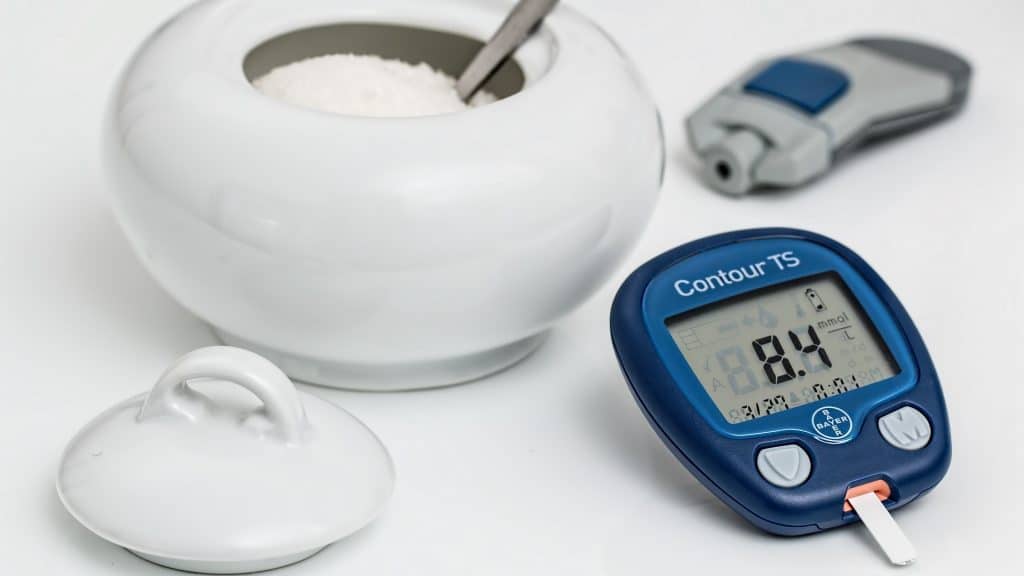How to Properly Manage Diabetes in Seniors

As the US population continues to live longer, we see an increasing number of diabetes in seniors. Around 25.9% of Americans aged 65 and above have diabetes, which accounts for over 12 million seniors (diagnosed and undiagnosed). Although diabetes is often linked to its impact on working-age adults, age–related diabetes is associated with increased mortality and reduced quality of life, and a greater risk of early isolation and institutionalization.
Diabetes in elderly is often accompanied by one or more other diseases which can complicate patient management. Our detailed guide will help you understand the disease and its management better.
What Is Diabetes?
Diabetes mellitus, or just diabetes, is a severe chronic disease. The main feature of diabetes is high blood glucose, commonly called high blood sugar. The level of glucose in the blood depends on the function of a hormone called insulin, produced by the pancreas. If cells can’t create or respond to insulin, too much glucose can accumulate in the blood.
Diabetes and Age: How Many Types of Diabetes Are There?
There are two main types of diabetes—type 1 and type 2 diabetes. While type 1 diabetes is characterized by low or no insulin production, type 2 is associated with reduced utilization of blood glucose in the tissues. Moreover, type 1 diabetes occurs most often in children and young adults, while type 2 occurs most often in middle-aged and older adults. Thus, most commonly, type 2 is a type of diabetes with old age onset.
A condition called “prediabetes” is used for people whose blood glucose levels are higher than the reference levels but still not high enough to be classified as diabetes. Prediabetes, however, is an underestimated problem because people who have it are at increased risk of developing insulin-independent diabetes (type 2).
Prediabetes and diabetes in seniors are associated with an unhealthy lifestyle. The chance of getting these conditions rises if the person is overweight, inactive, or has a family history of diabetes. Since the risk of diabetes steadily increases with age, seniors are more vulnerable to developing the disease.
Risk Factors for Developing Diabetes in Geriatric Patients
Several risk factors are leading to this condition:
- Being over 45 years old and having high blood pressure, obesity, or one or more family members with diabetes.
- Being over 55 years of age makes you more prone to develop type 2 diabetes.
- Having heart disease or having had a heart attack in the past.
- Having or having had gestational diabetes (high blood glucose during pregnancy).
- Having or having had borderline high blood sugar levels on testing (prediabetes).
- Having polycystic ovary syndrome along with obesity.
Can Diabetes in Seniors Be Prevented?
Fortunately, there are ways to lower the risk of developing diabetes. Although certain factors can’t be changed, such as genes, age, or past behaviors, possible ways to avoid diabetes include:
- healthy eating
- losing unnecessary weight
- being physically active
Doctors are essential for setting up plans for proper nutrition and regular exercise, as well as providing help for quitting smoking. However, most importantly, it’s necessary to check blood glucose levels regularly.
What Are the Symptoms of Diabetes in the Elderly?
There is a fundamental problem for older adults with diabetes. And that’s that the symptoms of diabetes in elderly patients may not be pronounced. Complaints such as feeling tired, hungry, or thirsty may be attributed to the normal aging process. Thus, older adults may not suspect they have diabetes.
Furthermore, the picture is completed by symptoms of diabetes in adults like unintentional weight loss, frequent urination, or blurred vision. Sometimes skin infections or slow-to-heal cuts and bruises are the main symptoms. Here, the role of the senior’s family or their family doctor to recognize any signs of diabetes is crucial. However, the state of undiagnosed diabetes in elderly people may stay that way until irreversible organ damage has been done. So, make sure it doesn’t come to that.
Tests Used for Diagnosing Diabetes in Older People
There are several blood tests for diagnosing diabetes. A random plasma glucose test, which is given at any time during the day, and a fasting plasma glucose test, where the blood is taken after at least eight hours without food, are routine laboratory tests. However, all individuals above 65 should be screened annually for diabetes.
If the doctor suspects early signs of diabetes in seniors, he will suggest an oral glucose tolerance test. It consists of two blood withdrawals: the first taken after fasting overnight, and the second, two hours after having a sugary drink. The A1C (glycosylated hemoglobin) test can be performed at any time during the day. Furthermore, it may determine the blood’s average glucose level for the past three months.
COVID-19, Age, and Diabetes Relationship
Worldwide, older adults with comorbidities like diabetes have the highest chances of COVID-19 adverse outcomes and mortality. What’s more, this has considerably impacted their ability to:
- access and get health care
- receive diabetes medications
- keep a healthy lifestyle
- maintain social relationships
Not to mention that worrying about catching the virus and avoiding hospitalization can create major psychological stress and impact their diabetes control. So, how is diabetes treated in the elderly during the pandemic?
Nowadays, telemedicine has become a norm. That involves apps or platforms where patients upload data from their continuous glucose monitors, glucometers, and insulin pumps for their doctors to make informed decisions. Be that as it may, not all older people with diabetes have computer access and are tech-savvy. Moreover, diabetes in the elderly statistics reveal that up to 44% of them have some form of cognitive dysfunction.
Because of all of the problems mentioned, families tend to move their loved ones from nursing homes to live with them during this pandemic. And even though their primary goal is caring for a diabetic patient, if the families aren’t equipped enough to address the patient’s health care needs, that may put the elderly at even greater risk of harm. So, establishing communication with the family for education and support on caring for their loved ones is crucial.
All in all, older people dealing with diabetes are an extremely vulnerable population that may encounter many challenges affecting their daily lives. However, clinicians may help them by guiding and supporting them through these hard times.
The Importance of Managing Diabetes in Older Adults
Fortunately, a diabetes diagnosis is not the end of the world. Taking control of blood glucose can prevent further problems. The family doctor can refer a diabetic senior to a specialist—an endocrinologist. Once the patient has been diagnosed with diabetes, the doctor will choose the best treatment based on:
- the type of diabetes
- patient’s everyday routine
- patient’s additional health problems
Managing type 2 diabetes in the elderly can be very successful. Sometimes even a change in diet and exercise can control blood glucose levels within the reference ranges. Some patients, however, need medicines or insulin injections. The most critical strategies are healthy lifestyle changes and proper medication.
Normal blood sugar levels for elderly adults range from 100 mg/dL to 60–70 mg/dL, depending on a laboratory’s reference range. According to the 2018 Clinical Practice Guidelines of the American Diabetes Association (ADA), prediabetes is established when fasting blood glucose varies between 100–125 mg/dL, whereas diabetes is diagnosed when fasting readings surpass 125 mg/dL. These numbers are the same for all adults, including seniors.
How to Keep Diabetes Numbers Under Control
There are specific strategies used to control diabetes and avoid complications to reduce its negative impact on quality of life. Managing diabetes in the elderly does not differ significantly from managing it in younger people except for special precautions due to any other diseases. Most importantly, tracking glucose levels is mandatory.
So, how can the elderly control diabetes? Here are the main precautions you need to take to keep diabetes under control:
Regularly Check Blood Glucose Levels
Running blood tests regularly at the lab or home is essential for monitoring and controlling diabetes in the elderly. Both very high (hyperglycemia) or very low blood glucose levels (hypoglycemia) can pose risks to the patient’s health.
Testing the percentage of A1C in the blood should be done at least twice a year. Even if the patients don’t control their diabetes well but managed to put their blood glucose level within the reference ranges for routine testing, the A1C test will show it.
A normal A1C for elderly people is between 7% and 7.5%, and it demonstrates the patient has had good glycemic control for the past three months. These values are associated with a negligible risk of all-cause mortality in patients with diabetes.
Make Healthy Food Choices
Seniors have to be encouraged to eat healthier by choosing good carbohydrate-containing foods such as fruit, vegetables, and whole-grain bread. They have to learn how different foods affect glucose levels, know how to watch their diet, and make healthy choices. Being educated on a suitable diabetes diet has proven its significance for diabetes patients, especially older ones.
Make Lifestyle Changes
Aside from diet compliance, patients should also monitor their weight and lose some excess pounds if they need to. For weight loss, consulting a nutritionist could benefit patients, but many also opt for appetite suppressing supplements.
Patients have to meet the challenge of balancing between losing weight and keeping the blood glucose levels within the normal ranges while using low-fat and low-sugar products. So, the diabetes diet elderly people consume is vital. Choosing the right foods to fulfill their needed vitamin levels is essential.
Diabetes in elderly people could also be controlled by daily exercising. Physical activity, within their abilities and under the guidance of a doctor, sustains glucose levels by improving their muscle utilization. Since muscle tissue is reduced in older people, exercising helps with diabetes and aging people.
Nevertheless, quitting smoking, especially in diabetes patients, significantly reduces the risk of many health problems, including stroke and heart attack. Adopting a healthier lifestyle that includes a nutritious diet, physical exercise, losing weight, and quitting smoking will only contribute to a patient’s well-being. In some cases, lifestyle changes may eliminate the need for diabetes medication.
Take Your Diabetes Treatment Seriously
Some patients need treatment with medications to maintain proper glucose levels in the blood. Some seniors receive oral diabetes tablets, whereas others need insulin. However, it’s essential to take diabetes medicines according to a doctor’s instructions—even when the patient feels good. It is important to share any concerns regarding prescribed drugs, including any side effects or difficulties in affording them.
Keep Your Cardiovascular System in Good Shape
Measuring blood pressure regularly and providing treatment for high blood pressure, if present, is a must in geriatric diabetes patients. Triglycerides and cholesterol, fats found in the bloodstream, should be checked regularly, at least once a year. The patient needs to know that high levels increase the risk of heart problems. Thus, the physician will ensure treatment with medications if fats levels in the blood are outside the normal range.
Get Routine Checkups to Discover Early Complications
Among the most sensitive organs to long-term hyperglycemia are the eyes and kidneys. Finding and treating eye problems, such as diabetic retinopathy, by attending yearly eye exams can keep your eyes healthy. Old age diabetes also attacks the kidneys, causing diabetic nephropathy. Therefore, routine urine and blood tests are recommended to track any kidney problems.
Be Wary of Diabetic Foot Problems
Diabetes patients’ feet should be checked every day for any signs of ulcers or infections, as they are some of the diabetes symptoms in the elderly. If the patients can’t do it by themselves, they should ask someone else to check their feet. If there are sores, blisters, breaks in the skin, infections, or a build-up of calluses, the patient should see a podiatrist. Wearing proper shoes is another great preventative measure.
Maintain Proper Skin and Oral Hygiene
Minor cuts that are difficult to heal could be one of the first signs of geriatric diabetes. Any wounds or bruises have to be managed accordingly to prevent infections. Keeping skin clean and using skin softeners for dryness are the best ways to protect it. Senior patients also have to pay attention to the care of their teeth and gums. Brushing teeth and flossing keep the problems away.
Protect Your Immune System
High glucose in the blood inhibits the circulating immune cells. Thus, people who have diabetes are more prone to infections than people with normal blood glucose levels. Regarding diabetes in the elderly guidelines recommend up-to-date vaccinations against pneumonia for people over 65 and a yearly flu shot. However, people who were younger than 65 when they had the pneumococcal vaccine may need another one after 65.
Be Prepared
It’s so easy to forget, but patients with diabetes should always have at least three days’ worth of supplies on hand to test their blood glucose and treat diabetes in case of an emergency.
Main Complications That Can Happen to a Senior Diabetic
Since diabetes can affect many organs, it is essential to keep blood glucose levels under control to minimize the impact of diabetes in the future. With diabetes in the elderly complications are often related to high blood pressure or high levels of certain fats in the blood that can speed up the progression of other common complications caused by diabetes.
Severe health problems such as
- heart disease
- stroke
- kidney disease
- vision loss
- nerve damage
- and circulation problems that may lead to amputation or erectile dysfunction (impotence) in men
could be considered complications of diabetes. Additionally, type 2 diabetes in elderly people is also related to having a higher risk of Alzheimer’s disease.
Conclusion
Diabetes in elderly people is a challenge; patients must stay in regular contact with their doctor. Working together with their doctors and other healthcare professionals, and diabetes educators could teach diabetes patients how to keep their diabetes under control and avoid complications.
Managing diabetes in the elderly population is particularly difficult. The condition is complex, requiring the involvement of multiple medical specialists. Moreover, the generally lower functional status of elderly patients can hamper the management of diabetes. Finally, published guidelines often do not apply to geriatric care.
Thus, physicians have to individualize therapeutic approaches to elderly patients, which can cause high variations in patient outcomes. However, understanding the specifics of geriatric diabetes patients will help in finding the best treatment. And follow-up care may also be found this way.
FAQs
What are the early signs of diabetes?
Common warning symptoms for both types of diabetes are hunger and fatigue, peeing more often and being thirstier, dry mouth, itchy skin, and blurred vision. For type 2 diabetes, additional symptoms include:
- yeast infections
- slow-healing sores or cuts
- pain or numbness in your feet or legs
What is the most common type of diabetes found in the elderly?
The most common type of diabetes found in seniors is type 2—previously called insulin-independent diabetes. Type 1 diabetes in elderly people is quite rare. In fact, type 1 diabetes is inherited and usually diagnosed much earlier, typically in infancy.
What is the normal blood sugar level for the elderly?
Normal blood sugar levels for the elderly are defined as less than 100 mg/dL. Fasting readings above 100–125 mg/dL are classified as prediabetes, as per the elderly blood sugar levels chart. And fasting blood glucose above 125 establishes the diagnosis of diabetes.
How do you feel when your blood sugar is too high?
Some of the most common symptoms associated with hyperglycemia include: thirst, tiredness, blurry vision, frequent urination, as well as unintentional weight loss. Very high blood sugar can cause you to faint, feel nauseated, and even throw up. It can also cause dehydration, especially in older people.
Can high blood sugar cause confusion in the elderly?
Confusion is related more to hypoglycemia than to hyperglycemia. A low blood glucose level also leads to other very unpleasant symptoms such as:
- speech and self-care difficulties
- aggressive behavior
- unsteadiness and falls
- losing consciousness
- cognitive damage
- heart attack or stroke
Can you get rid of diabetes?
Diabetes, like hypertension, is a lifelong disease. Thus, it cannot be cured. However, by controlling the blood glucose within the reference ranges, the patient will feel relatively healthy. Moreover, studies have shown that people can reach and keep normal blood sugar levels without any medication through diet changes and weight loss.
What happens if you leave diabetes untreated?
If diabetes remains untreated, this puts the patients at significant risk of a range of severe health problems. Some of the potential complications are stroke, heart disease, nerve damage, and kidney damage. Fortunately, these risks can be vastly reduced by appropriate medical treatment and lifestyle changes.
Can you claim any benefits for being diabetic?
Diabetes is listed in the so-called “Blue Book,” which is the impairment listing manual of the Social Security Administration. Diabetes, regardless of the type, is a condition that can qualify a person for Social Security Disability benefits.
To be eligible for any gains on the basis of diabetes diagnosis, the patient should be diagnosed as having diabetes mellitus (type 1 or type 2) and at least one of the following conditions: neuropathy, acidosis, or diabetic retinopathy. After approval, the patient will receive a vocational medical allowance not to return to their previous work or perform any new but unsuitable types of work.
Can diabetes kill you?
Diabetes itself cannot kill you. However, long-term high concentrations of blood glucose can lead to enormous damage to nearly every major organ in the body, including:
- kidney damage and failure
- artery damage, which increases the risk of stroke and heart attack
- nerve damage, which can lead to traumatic injury, and
- infection, possibly leading to limb amputation
Thus, the mortality rate of diabetes in seniors is increased due to diabetic complications.






